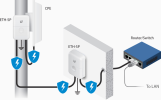I'm setting up a home network and surveillance system and want to run all the cables to a patch panel and then to one or two switches. As I understand it, the best practice is to keep the surveillance network separate from a home network. So I could go for two 8-port PoE switches or one 16-port managed switch if it provides the flexibility to separate two or more networks and is not too expensive. As this setup will be rack-mounted, I would prefer a 1U height switch or a combination of switches. Some of the outdoor cameras are in remote locations so outdoor shielded cable is used with a shielded patch panel.
I'm still looking at what kind of rack to get as since it will be mounted in a shed with an open floor, it should probably be enclosed.
The reason for wanting the home network to have PoE support is to allow for wired access points. The shed is within 20' of the house, the garage is 75' away and another shed is 200' away. There will probably be two or three access points for outdoors and two for the house indoors. I haven't settled on which AP's would be suitable.
At this point, I've not decided whether to purchase an NVR or a NUC type computer or NAS with dual network interfaces. In any case, the video recorder would be added to the rack in the shed where there are no temperature controls so the temperature range could be from below 0F to over 100F (-18C to 38C).
Thanks for any input.
-Bill
I'm still looking at what kind of rack to get as since it will be mounted in a shed with an open floor, it should probably be enclosed.
The reason for wanting the home network to have PoE support is to allow for wired access points. The shed is within 20' of the house, the garage is 75' away and another shed is 200' away. There will probably be two or three access points for outdoors and two for the house indoors. I haven't settled on which AP's would be suitable.
At this point, I've not decided whether to purchase an NVR or a NUC type computer or NAS with dual network interfaces. In any case, the video recorder would be added to the rack in the shed where there are no temperature controls so the temperature range could be from below 0F to over 100F (-18C to 38C).
Thanks for any input.
-Bill

